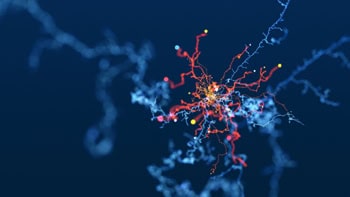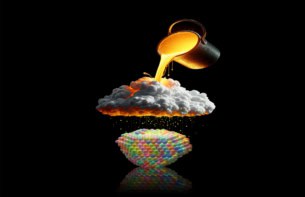
Physicists in the US have discovered that large clusters of skyrmions in a liquid crystal undergo collective motions, much like schools of fish. Hayley Sohn and colleagues at the University of Colorado, Boulder, first spotted the behaviour by accident, but quickly realized that they had discovered an intriguing new form of active matter. Their work could lead to the development of new types displays with the potential to transform the ways in which humans and computers interact.
Soft matter systems like liquids, polymers and foams can sometimes exhibit coordinated life-like behaviour that resembles a school of fish escaping a predator or a cluster of living cells organizing itself into a biological structure. These active soft-matter systems have a range of technological applications and the challenge for scientists is how to fine-tune interactions between individual components – such as molecules in a liquid crystal – to get the desired behaviour.
The initial focus of Sohn and colleagues was not to develop methods of control, but rather to study the dynamics of large numbers of topological solitons, or skyrmions, within a liquid crystal. Skyrmions are particle-like excitations that propagate through the material.
Drastic change
Their latest insight came unexpectedly when the team left its experiment alone while on break and returned to find that it had changed drastically. Instead of being randomly oriented as they had expected, the skyrmions had adopted highly synchronized motions. With further experiments, the team found that the structures had developed a polar order within seconds; grouping into fish-like schools through their elastic interactions. These groups then moved around along spontaneously chosen directions.
The observation is unprecedented in active matter systems because, unlike typical building blocks, skyrmions have no physical boundaries, chemical compositions, or density gradients. Furthermore, Sohn and colleagues discovered a versatile technique for controlling the behaviour of the skyrmion schools. This involves tuning an applied oscillating voltage, which changes the elastic interactions between skyrmions.

Skyrmion bags point the way to high-density data storage
Sohn and colleagues believe that their discovery could lead to the development of versatile, reconfigurable active matter. If successful, such technology could be used for applications ranging from realistic models of biological systems, to video games in which unexpected events occur without any necessary programming.
The researchers have also showed that the conditions under which the collective behaviour occurs are much like those found in liquid crystal displays. This, they believe, could bring about significant new advances in the display technologies.
The research is described in Nature Communications.



